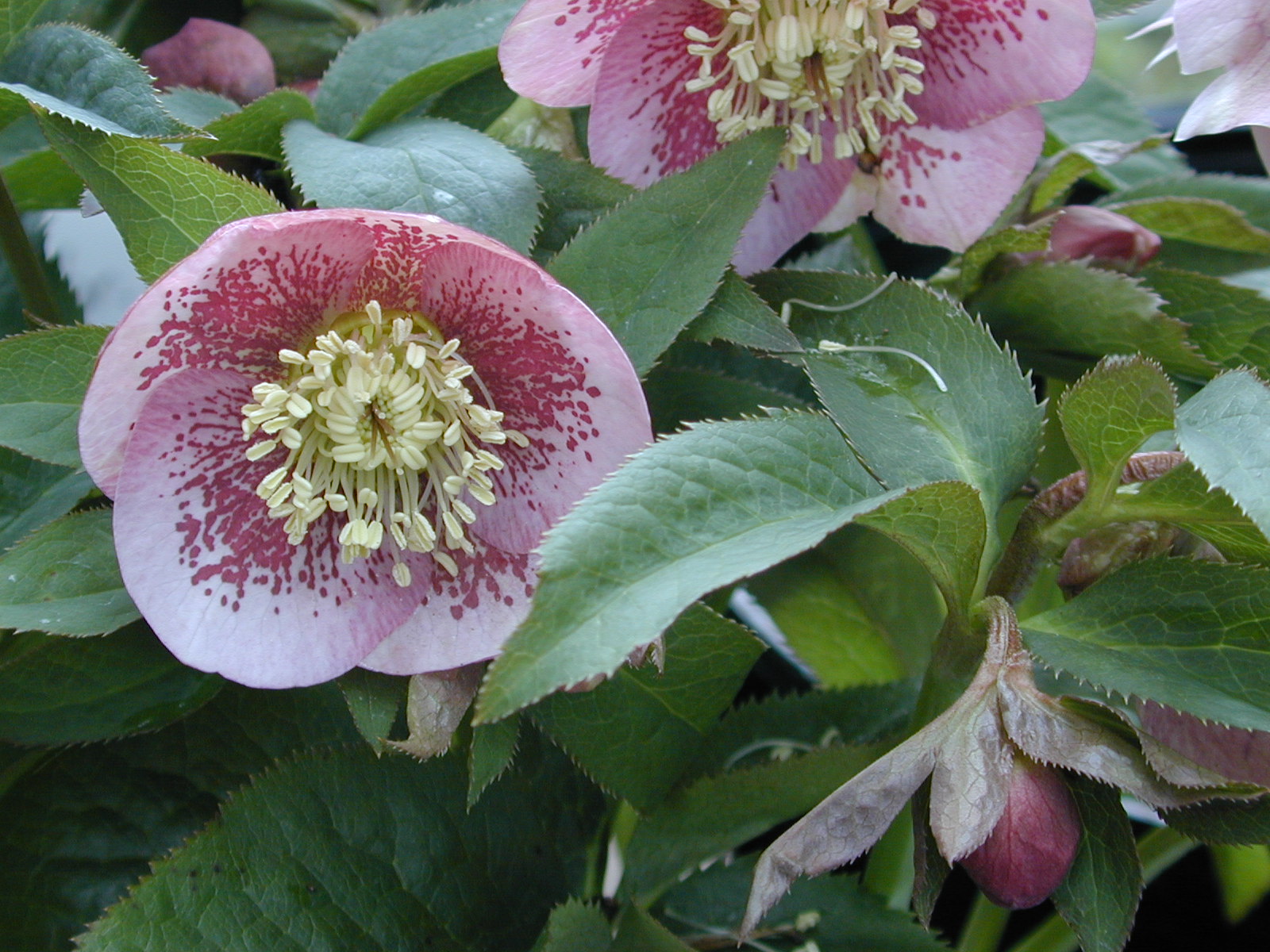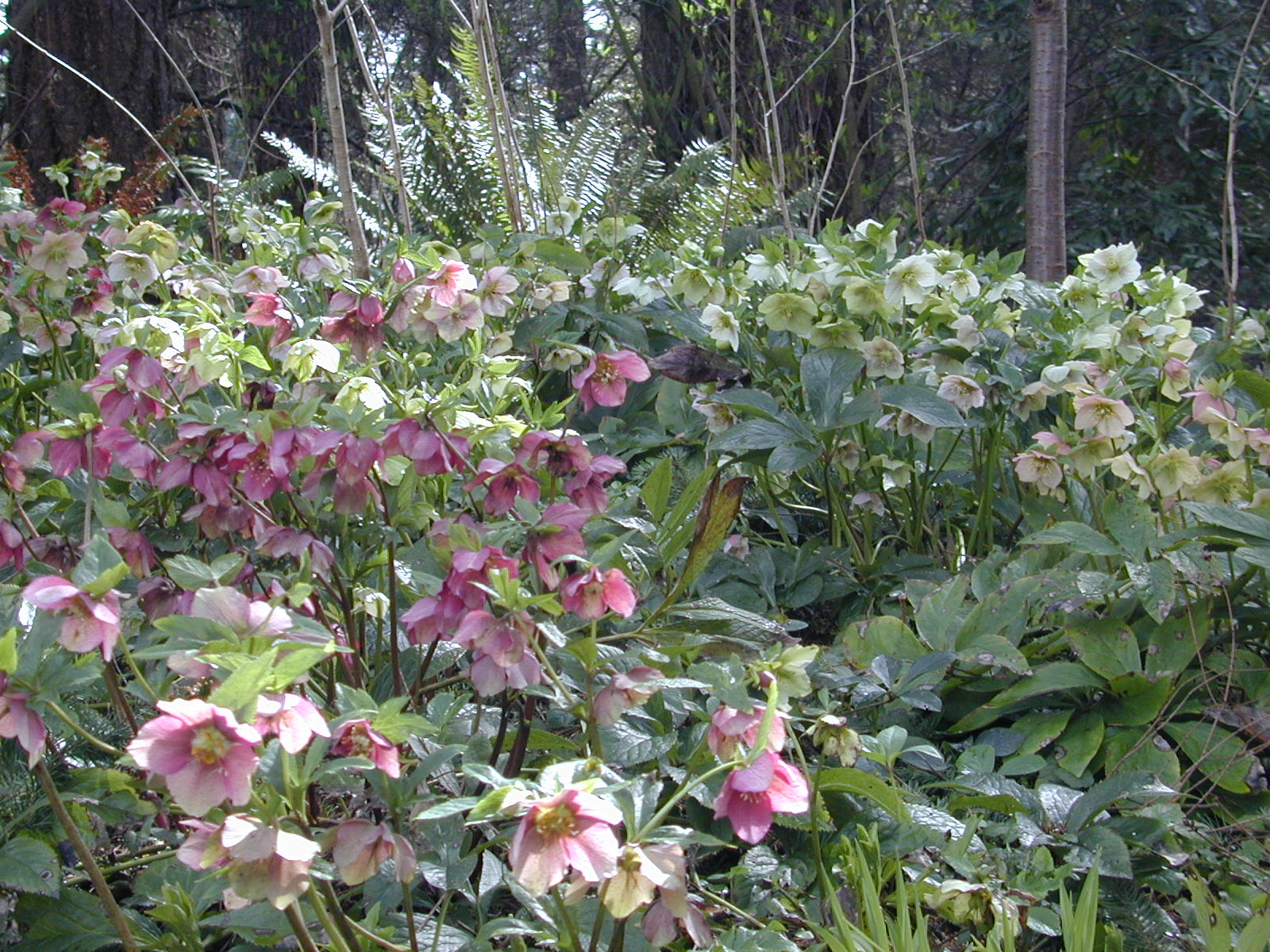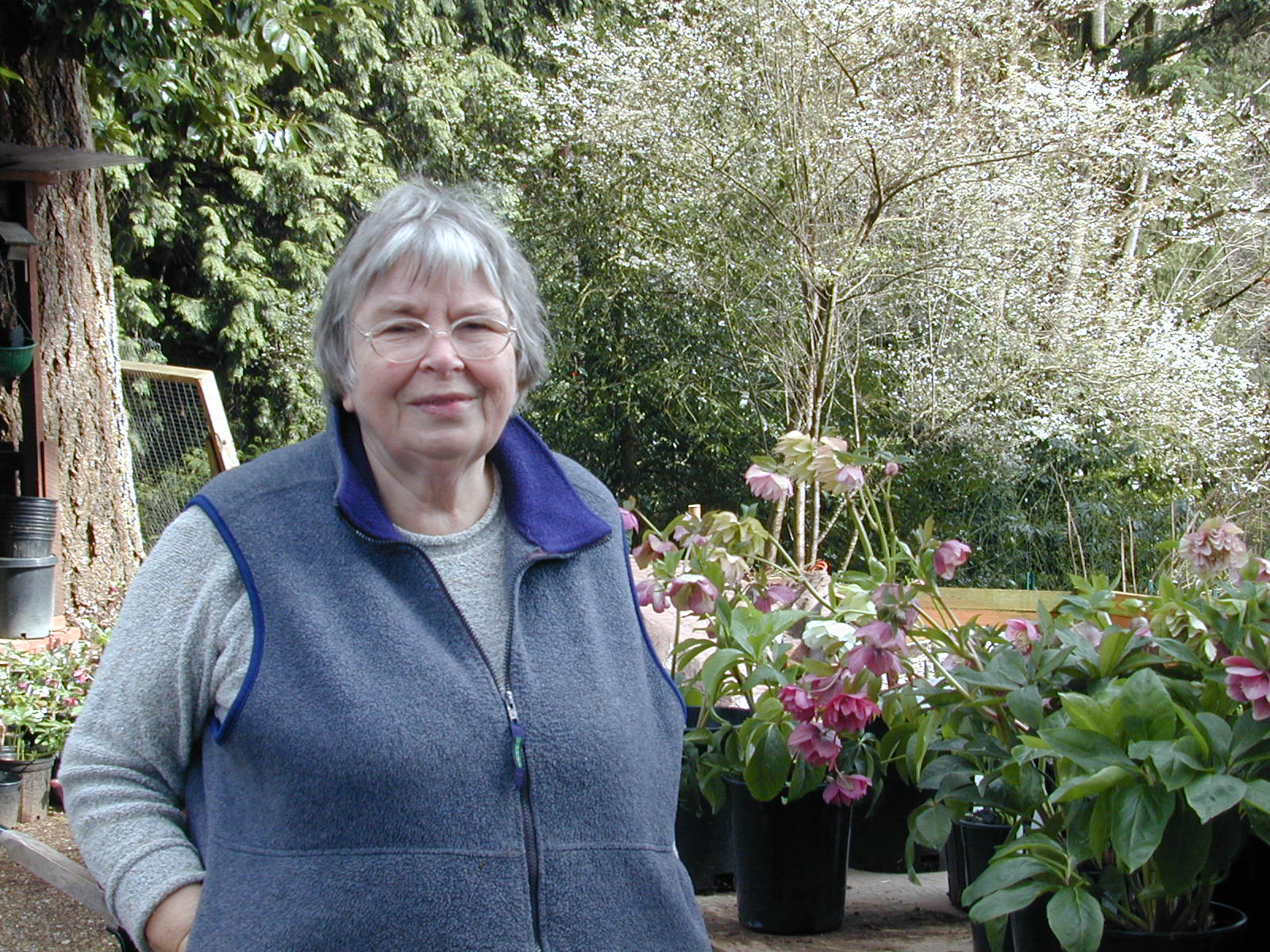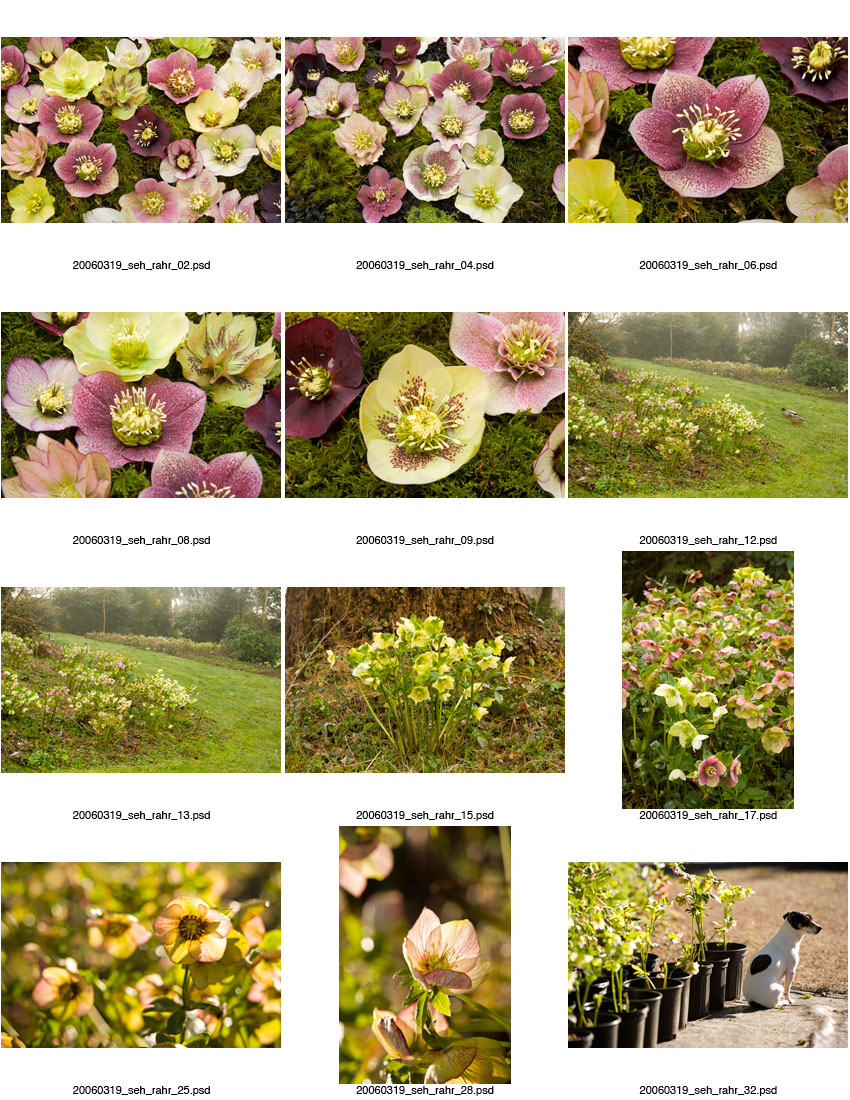
Romantic hellebores brighten the garden during the grayest season
[Note: This article is truly “from the archives,” adapted from a piece originally published in the December 2006 issue of now-defunct Seattle Homes & Lifestyles with photography by Bill Wright. These images are mine.]
On a damp Northwest morning in Elfi Rahr’s Bellevue, Wash., garden, a layer of mist floats over a gently sloping lawn and settles above a pair of crescent-shaped borders, resplendent in drifts of pink, white and plum flowers. As the occasional ray of sun illuminates the garden, hundreds of blooms appear to lift their heads toward the daylight.
It’s wintertime, when hellebores emerge from the wet, bare earth to deliver a bouquet of beauty at the most unexpected time of year.
 “Hellebore season” is more than a celebration of the flower that’s commonly known as Christmas rose or Lenten rose. It’s the time of year when, after backbreaking months collecting and sorting more than 20 pounds of tiny, fresh hellebore seeds, this expert grower enjoys the fruits of her labor.
“Hellebore season” is more than a celebration of the flower that’s commonly known as Christmas rose or Lenten rose. It’s the time of year when, after backbreaking months collecting and sorting more than 20 pounds of tiny, fresh hellebore seeds, this expert grower enjoys the fruits of her labor.
 A horticultural magician, Elfi is a dedicated amateur-turned-professional whose hybridizing efforts conjure up unforgettable new varieties of hellebores, influencing gardeners around the world. With her husband, Bill Rahr, this seventy-something plantswoman operates Hellebores Woodland Gardens, a wholesale nursery in Bellevue. “I have a bad case of helleboritis,” she chuckles, her shy smile lighting up when she stops at the edge of a path to lift the face of a buttery yellow hellebore flower, borne on a 10-inch stem.
A horticultural magician, Elfi is a dedicated amateur-turned-professional whose hybridizing efforts conjure up unforgettable new varieties of hellebores, influencing gardeners around the world. With her husband, Bill Rahr, this seventy-something plantswoman operates Hellebores Woodland Gardens, a wholesale nursery in Bellevue. “I have a bad case of helleboritis,” she chuckles, her shy smile lighting up when she stops at the edge of a path to lift the face of a buttery yellow hellebore flower, borne on a 10-inch stem.
 Even more contagious than her smile is Elfi’s affection for this charming plant, which she recalls fondly from her native Germany. The relationship with the genus Helleborus began innocently enough: “I was looking for an early nectar source for my husband’s honey bees. I used to take bouquets of hellebores to the arboretum groups asking the members to plant these flowers in their garden.”
Even more contagious than her smile is Elfi’s affection for this charming plant, which she recalls fondly from her native Germany. The relationship with the genus Helleborus began innocently enough: “I was looking for an early nectar source for my husband’s honey bees. I used to take bouquets of hellebores to the arboretum groups asking the members to plant these flowers in their garden.”
After Elfi inherited seedlings from a friend’s garden, she began experimenting with hellebores in the early 1970s. Today, Elfi and Bill’s four-acre landscape is home to thousands of hellebores. Many grow in woodland beds and borders, while seedlings and young plants fill trays and nursery pots.
Elfi says sheer intrigue drives this solitary venture.
“It’s fascinating to see that starting with one plant leads to offspring with so many variations.”
 When the weather warms, she hand-pollinates endless combinations of plants, tying colored embroidery floss around the necks of “parent” flowers and seedlings to track the outcome of every pairing. And if one or two special offspring emerge, perhaps bearing evenly-spaced flecks or revealing a luscious apricot shade, Elfi marks them for future evaluation.
When the weather warms, she hand-pollinates endless combinations of plants, tying colored embroidery floss around the necks of “parent” flowers and seedlings to track the outcome of every pairing. And if one or two special offspring emerge, perhaps bearing evenly-spaced flecks or revealing a luscious apricot shade, Elfi marks them for future evaluation.
“I’m trying very hard to get the color and markings equal on each sepal (or petal) because in the breeding business, you have to pay attention to that.”
 Other desired traits include the elusive black hellebore (deep purple is the closest anyone has come to it) or a stem that holds upright its velvety flower head. Most hellebores tend to turn their blooms down, resembling tiny umbrellas (especially noticeable when it rains).
Other desired traits include the elusive black hellebore (deep purple is the closest anyone has come to it) or a stem that holds upright its velvety flower head. Most hellebores tend to turn their blooms down, resembling tiny umbrellas (especially noticeable when it rains).
Jelitto, a giant German-based seed company, markets Elfi’s hellebore seeds worldwide to customers in 49 countries, including her registered Winter Queen strain. Like one-of-a-kind snowflake patterns, the distinct faces of Elfi’s hellebores are unique and eye-catching – especially when viewed up close. Paler blossoms are often marked with splotches or veining and with deep burgundy nectaries, giving these varieties the name Picotee. The fringed yellow centers resemble those of peonies (both plants are actually members of the Ranunculaceae, or buttercup family).
 Hellebores may be “singles,” with five sepals (or petals); “anemones,” also considered semi-doubles, with a ruff of large curved nectaries around the base of the center filaments; or “doubles,” bearing three to four rows of petals, with the inside row frequently ruffled.
Hellebores may be “singles,” with five sepals (or petals); “anemones,” also considered semi-doubles, with a ruff of large curved nectaries around the base of the center filaments; or “doubles,” bearing three to four rows of petals, with the inside row frequently ruffled.
Long-blooming, with nearly evergreen foliage, the hellebore is an excellent perennial for Northwest gardens. The plant looks especially stunning when planted in masses, where the subtle gradations dazzle the eye, such as a bank of Elfi’s hellebores that ranges from pale rose to a mid-tone purple to deep ruby reds and dark, dusty plums. “When these are backlit by the sun, they glow like a glass of red wine,” she says.
Dark flowers alone don’t show up well in the winter landscape, so Elfi prefers to plant white, cream and yellow varieties throughout the garden where they illuminate darker beds and can be seen from a distance.
Which type of hellebore does Elfi love most? “My favorites are still unborn,” she confides. “There are always new creations, new fascinations.”

Create a hellebore tabletop display
One way to appreciate the beguiling shades, markings and forms of hellebore flowers is to cut them and float the blossoms in shallow bowls of water. The flowers will last about one week indoors, Elfi says. She prefers to create miniature woodland displays, layering the hellebore blooms in a moist, gravel-filled tray and using bright green moss to offset the flower colors. Outdoors, these tableaux resemble elaborate Victorian wallpaper patterns – and can last up to three weeks.
–Debra Prinzing
 Growing tips:
Growing tips:
If you don’t have a few of the pale green, cream or rose-colored hellebores in your garden, now is the time to plant these glorious woodland perennials. You’ll be magically rewarded each winter to come, when oval-shaped hellebore buds unfold to show off dreamy blooms surrounded by collars of shiny green foliage – and the flowers are bound to last for weeks.
Most nurseries sell hellebores in one- or two-gallon pots. Look for a plant with healthy stems and green foliage. There should be at least three to five buds on each stem. If you have a specific color in mind, wait until it is in bloom before purchasing it, Elfi advises.
Hellebores tolerate clay or loamy soil. If you have sandy soil, amend the planting area with organic compost before you plant. “Hellebores are heavy feeders in spring and they do flourish with a good helping of compost,” she says.
Situate your plants in full shade to partial shade. Plant them about three feet apart. “Never cover the crown of your hellebore plant with compost or it will begin to rot,” Elfi adds. She plants hellebores slightly higher than the soil level to avoid this problem.
Hellebores are a good choice for drought-tolerant landscapes. “The plants go dormant from June to October and if they show signs of wilting, ignore it,” she says. Once the rain begins to fall, these durable perennials rebound quickly.
–Debra Prinzing
